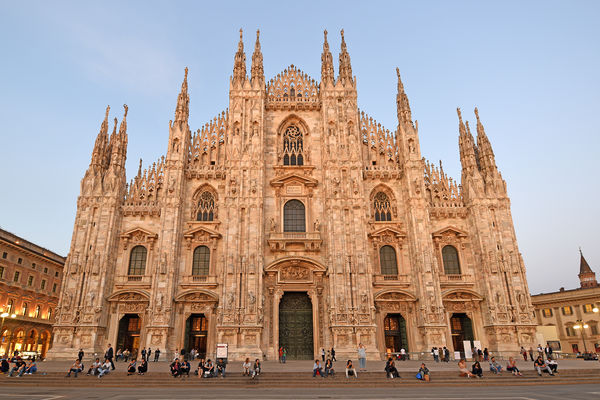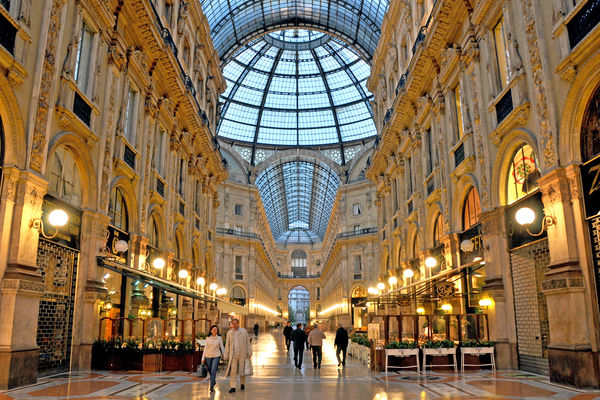Historic Hits in Mod Milan
By Rick Steves

While much of Italy's appeal is rooted in its relaxed pace and Old World feel, Milan — the nation's second city and financial capital — offers just the opposite. But travelers who make time for Milan find that this modern, industrious metropolis packs historic highlights as powerful as other Italian cities'.
I'd start a first visit (well, any visit) at the heart of the city: Piazza del Duomo, which is dominated by Milan's cathedral, the Duomo di Milano. It's the third-largest church in Europe, after St. Peter's in Rome and the Cathedral of Sevilla in Spain. To build it, the Milanesi used the most expensive stone they could find: pink marble.
The facade is a commotion of Gothic features — pointed-arch windows, statues, little pinnacles, and reliefs. Scholars count a thousand individual carvings — big and small — on the church exterior and another 2,000 sculptural elements inside. Once you step through the entrance, you're struck by the immensity of the place. The soaring ceiling is supported by sequoia-size pillars.
After touring the interior, you can climb the stairs — or take an elevator — to the marble-paved roof, 20 stories up, for the most memorable part of a Duomo visit. Up here, wandering through a fancy forest of spires, you'll notice that the saint statues suddenly become more lifelike up close. Beyond the statues lies a stunning view: On a clear day you can see all the way to the Alps. A 15-foot-tall gilded statue of the Virgin Mary on the tallest spire overlooks it all.
Back on the ground, one side of Piazza del Duomo is dominated by a grand arch — it marks the entrance to the Galleria Vittorio Emanuele II, built as one of the first shopping malls in the world. Then as now, it was home to shops and cafés and lots of strolling locals. Today, you can linger among luxury stores such as Gucci, Louis Vuitton, and Prada.
Though it looks like it's built of stone, the Galleria is actually a skeleton of iron beams faced with stone and topped with glass. When it was built (between 1865 and 1877), it was the marvel of its day and proclaimed Milan as the most cultured city of a newly united Italian nation. Later, the Galleria was the first building in Milan to have electric lighting.
If you cut through the Galleria from the cathedral square, you'll pop out at Piazza della Scala, home of the La Scala Opera House and Museum. Teatro alla Scala first opened its doors in 1778 and quickly established itself as one of the premier opera theaters in Europe. The stage is enormous, the acoustics are wonderful, and the talent has always been top-notch. Many of the greatest operas got their first performance here — Madame Butterfly, Nabucco, Turandot. Almost all of the great opera singers — from Caruso to Callas to Pavarotti — have sung here. But unless you have tickets to a performance (expensive and often hard to get), you'll be limited to the adjacent museum. While the museum has an extensive collection sure to thrill opera buffs (original scores, Verdi's top hat, Rossini's eyeglasses, Toscanini's baton, Fettuccini's pesto), the main reason to visit is the opportunity it offers (on most days) to peek into the actual theater.
Milan's most famous sight, The Last Supper, is away from the city center. Leonardo's fragile fresco survives — just barely — inside the Church of Santa Maria delle Grazie, centuries after it was painted right onto the wall of what had been the church's dining hall. (Deterioration began within six years of its completion, plus the church was bombed in World War II — but the wall holding The Last Supper remained standing.) Though today it's in a humidity-regulated room that strictly limits the number of visitors, most of the original paint is gone. Still, visitors come from around the world to see what's left of this remarkable work — reservations are mandatory, and should be booked three months in advance.
The exactingly crafted fresco is a masterpiece of natural-looking lighting and expressive faces. Christ and his 12 apostles are eating their last meal before Jesus is arrested and executed. Leonardo captured the moment of psychological drama when Jesus says that one of the disciples will betray him. The apostles huddle in stressed-out groups of three, wondering, "Lord, is it I?"
Leonardo spent three years on The Last Supper. It's said that he went whole days without painting a stroke, just staring at the work. Then he'd grab a brush, rush up, flick on a dab of paint…and go back to staring.
Milan may be overshadowed by Venice and Florence as a tourist destination, but this stirred-up melting pot of people, industry, and history is one of the top treasures of the wonder that is modern-day Italy.

